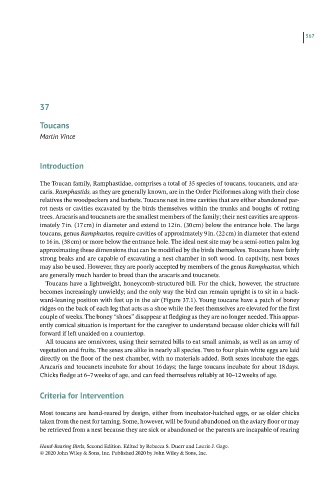Page 566 - Hand rearing birds second
P. 566
567
37
Toucans
Martin Vince
Introduction
The Toucan family, Ramphastidae, comprises a total of 35 species of toucans, toucanets, and ara-
caris. Ramphastids, as they are generally known, are in the Order Piciformes along with their close
relatives the woodpeckers and barbets. Toucans nest in tree cavities that are either abandoned par-
rot nests or cavities excavated by the birds themselves within the trunks and boughs of rotting
trees. Aracaris and toucanets are the smallest members of the family; their nest cavities are approx-
imately 7 in. (17 cm) in diameter and extend to 12 in. (30 cm) below the entrance hole. The large
toucans, genus Ramphastos, require cavities of approximately 9 in. (22 cm) in diameter that extend
to 16 in. (38 cm) or more below the entrance hole. The ideal nest site may be a semi‐rotten palm log
approximating these dimensions that can be modified by the birds themselves. Toucans have fairly
strong beaks and are capable of excavating a nest chamber in soft wood. In captivity, nest boxes
may also be used. However, they are poorly accepted by members of the genus Ramphastos, which
are generally much harder to breed than the aracaris and toucanets.
Toucans have a lightweight, honeycomb‐structured bill. For the chick, however, the structure
becomes increasingly unwieldy; and the only way the bird can remain upright is to sit in a back-
ward‐leaning position with feet up in the air (Figure 37.1). Young toucans have a patch of boney
ridges on the back of each leg that acts as a shoe while the feet themselves are elevated for the first
couple of weeks. The boney “shoes” disappear at fledging as they are no longer needed. This appar-
ently comical situation is important for the caregiver to understand because older chicks will fall
forward if left unaided on a countertop.
All toucans are omnivores, using their serrated bills to eat small animals, as well as an array of
vegetation and fruits. The sexes are alike in nearly all species. Two to four plain white eggs are laid
directly on the floor of the nest chamber, with no materials added. Both sexes incubate the eggs.
Aracaris and toucanets incubate for about 16 days; the large toucans incubate for about 18 days.
Chicks fledge at 6–7 weeks of age, and can feed themselves reliably at 10–12 weeks of age.
Criteriafor Intervention
Most toucans are hand‐reared by design, either from incubator‐hatched eggs, or as older chicks
taken from the nest for taming. Some, however, will be found abandoned on the aviary floor or may
be retrieved from a nest because they are sick or abandoned or the parents are incapable of rearing
Hand-Rearing Birds, Second Edition. Edited by Rebecca S. Duerr and Laurie J. Gage.
© 2020 John Wiley & Sons, Inc. Published 2020 by John Wiley & Sons, Inc.

